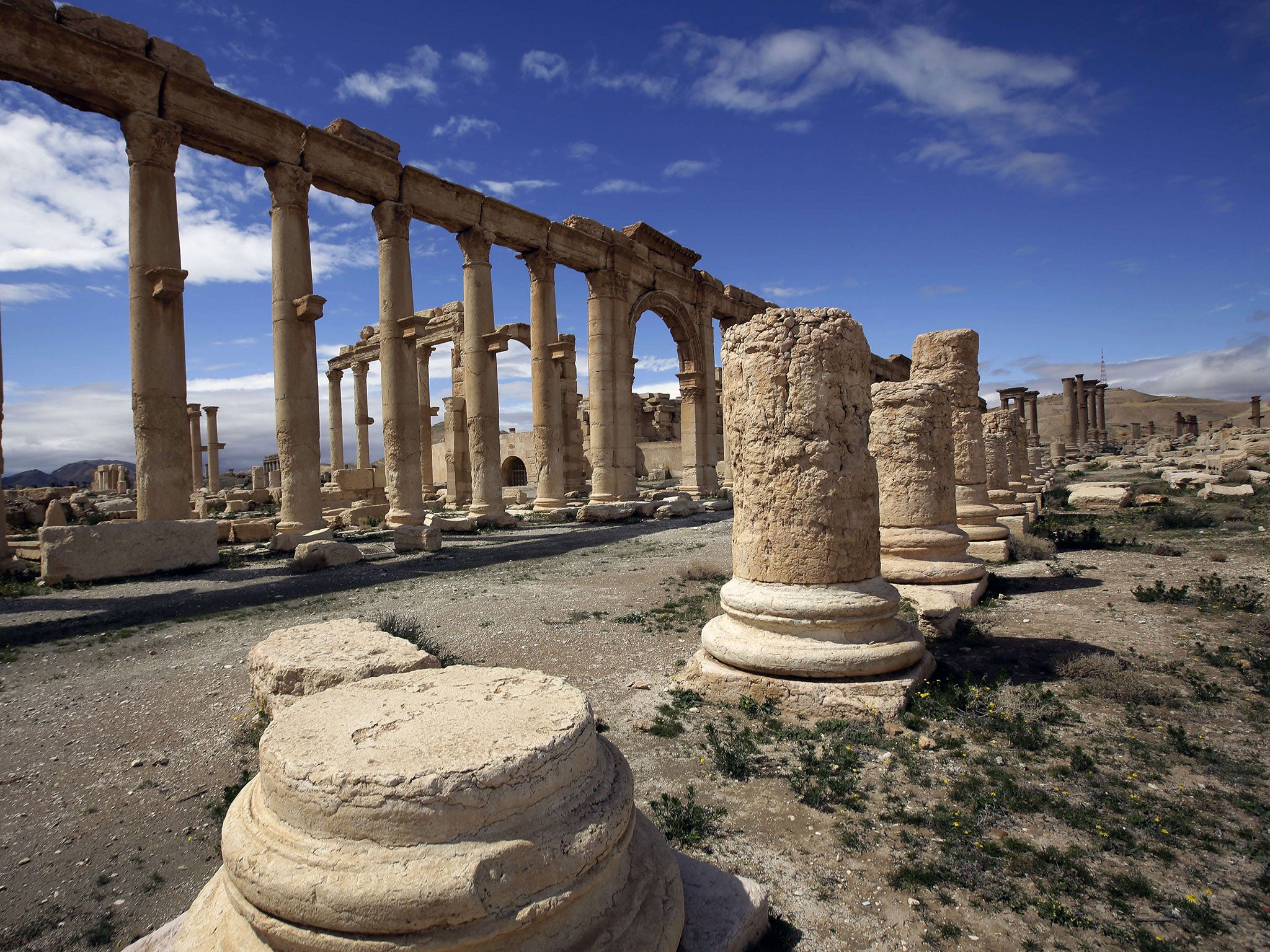Anyone who bothers about the stones of Palmyra will also care about the souls of Tadmur
The distinction between a concern for the fate of people and of antiquities is a false dichotomy


Your support helps us to tell the story
From reproductive rights to climate change to Big Tech, The Independent is on the ground when the story is developing. Whether it's investigating the financials of Elon Musk's pro-Trump PAC or producing our latest documentary, 'The A Word', which shines a light on the American women fighting for reproductive rights, we know how important it is to parse out the facts from the messaging.
At such a critical moment in US history, we need reporters on the ground. Your donation allows us to keep sending journalists to speak to both sides of the story.
The Independent is trusted by Americans across the entire political spectrum. And unlike many other quality news outlets, we choose not to lock Americans out of our reporting and analysis with paywalls. We believe quality journalism should be available to everyone, paid for by those who can afford it.
Your support makes all the difference.Last Sunday, I heard a leading Muslim intellectual talk in sorrow and even anger about the reckless damage inflicted by extremists on cultural treasures in an Arab land.
The subject was not ancient Palmyra – which has just fallen to Isis as the jihadi army sweeps through Syria – but a city in the grip of another totalitarian regime. At the new, and excellent, Bradford Literature Festival, Ziauddin Sardar outlined the destruction wrought on the historic heritage of Mecca by its Saudi custodians. He spoke, by the way, in Bradford’s gorgeous neo-Venetian Wool Exchange – now a branch of Waterstones. That jewel somehow escaped the “progressive” wrecking ball that blitzed so much fine Victorian architecture.
As Sardar explains in his history of Mecca, the Saudi authorities have bulldozed scores of early Islamic and Ottoman monuments to erect a crassly vulgar “amalgam of Disneyland and Las Vegas”. This iconoclastic fury serves the kingdom’s aim of monetising the pilgrimage to Mecca, the hajj, into an ever-growing source of non-oil revenue. Wreckers in the guise of guardians, the Saudis have even levelled the land itself for their highway and high-rise hell.
As for the city’s historic sites: “The house of Khadijah, the first wife of the Prophet Mohamed, has been turned into a block of toilets. The Makkah Hilton is built over the house of Abu Bakr, the closest companion of the prophet and the first caliph.”
To Wahhabi puritans, such as the Saudi rulers, even the reputed birthplace of the prophet himself may count as a temptation to idolatry and thus a target for annihilation. Their vandalistic zeal may differ in tone but not kind from the trail of wreckage that Isis has already left behind among the artefacts of Mosul and in the Assyrian city of Nimrud. Now the oasis city where Greco-Roman and Persian cultures commingled for centuries lies at its mercy. If they raze the ruins of Palmyra – and no reports of demolition have, as I write, emerged – the zealots will not much care that they wipe out the traces of a great conqueror of Arab origin. In fact, they might enjoy the idea of obliterating the capital of a mighty woman warrior. Around AD270, Queen Zenobia (a Latinised version of Zaynab) surged out of her desert fastness in Palmyra to conquer Egypt, Syria, Palestine and much of Asia Minor.
As a distinctly 21st-century cult, Isis seeks to stir panic via media-manipulated outrage. Shattered stones and harrowed bodies can both secure that goal. For many lovers of ancient beauty, though, a nagging worry remains that regret at artistic desecration may take the place of sympathy with human suffering.
A visitor to Palmyra who has just posted pictures on the BBC website writes that he found something “slightly disquieting about feeling so strongly about the destruction of such astonishing cultural artefacts given the likely human toll”. Only a marble-hearted aesthete would not share that twinge. Yet Heinrich Heine wrote the first, and last, word about such pangs of conscience: “Where they burn books, they will in the end burn people too.” Many people know Heine’s line, which now graces a plaque on the Bebelplatz in Berlin, where the Nazis stoked their literary bonfire in May 1933. Fewer know its original context. It comes from his 1821 tragedy Almansor, and refers to burnings of the Koran by the Spanish Inquisition.
With Isis, the breaking of “heathen” statues and “heathen” bodies belongs to the same jihad. Both serve the struggle for absolute monotheism against idolatry. Yazidis, Shias, Christians, Jews and indeed anyone who offends the Isis leadership no more deserves to survive than a carved Assyrian bull or a sculpted Roman goddess. Some 2,000 miles from the battlefront, we can respond to this iconoclastic mayhem with mourning, rage or defiance. The one reaction in which we should not indulge is bafflement at some alien, exotic passion. For Palmyra’s, or Nimrud’s, present was our past. “And this also,” says Joseph Conrad’s Marlow, as his ship lies at anchor in the Thames at the start of Heart of Darkness, “has been one of the dark places of the earth.”
People in Britain grow up in a cultural landscape damaged and depleted by two fierce spasms of fanatical destruction. First, the dissolution of the monasteries masterminded in the 1530s by our new hero Thomas Cromwell opened the way for a Protestant onslaught on image-based Catholic devotion. Precisely because (as with Isis) they represented a tiny minority, the most radical reformers whitewashed paintings, melted relics and smashed glass with an almost demented zeal.
To material ruin the militants added symbolic defacement. In 1547, after Edward VI had come to the throne, a royal order commanded clergy to “take away, utterly extinct and destroy all shrines, pictures, paintings and all other monuments of feigned miracles, pilgrimages, idolatry and superstition; so that there remain no memory of the same”. Joseph Stalin, let alone the Isis “caliph” Abu Bakr al-Baghdadi, would be proud of that last phrase.
We can know the glory of what was lost only by the handful of treasures rescued from the storm. For some reason, St Mary’s church at Fairford, Gloucestershire, preserves an intact set of 28 stained-glass windows installed in the early 1500s by Flemish immigrant master-glaziers. Tourists now arrive to view, as an extreme rarity, an aesthetic feature that St Mary’s would have shared with hundreds of other prosperous parishes. Far beyond the ranks of diehard Catholics, the English and Scots felt the ache of their loss. In Sonnet 73, Shakespeare refers to “Bare ruined choirs, where late the sweet birds sang”. It’s hard to read that line and not think of the gaunt and gutted skeletons of looted abbeys, at Rievaulx, Tintern or Fountains. In some of its most romantic corners, the British countryside is in effect a cultural crime scene: a horror-show of wanton desecration far beyond anything Isis will ever achieve.
The hammer of God swung again in the 1640s. In the chaotic early years of civil war, Puritan radicals returned to finish what the Tudors had begun. In 1643, parliament even created a “Committee for the Demolition of Monuments of Superstition and Idolatry”. Much-loved medieval landmarks, such as Cheapside Cross in London, fell to the radical fringe. In East Anglia, William Dowsing toured towns on a mission to smash every idolatrous image he could find. But at King’s College, Cambridge, in the cold midwinter of 1643, Parliamentary troops had requisitioned the chapel as a billet. So he rode away, and some of the greatest glass in England by chance endured. In Henry VII’s Lady Chapel at Westminster Abbey, an equivalent masterpiece soon lay in irrecoverable shards.

We live amid a landscape of ruins, remnants of an art and architecture that appalled our home-grown sectarian dogmatists. Other European cultures have a parallel history: the eradication of much Islamic culture in Spain and Portugal; the plunder of ecclesiastical riches after the French Revolution; the Nazi and Soviet wars against every non-party brand of beauty. The very idea of “iconoclasm” comes from the two waves of ecclesiastical image-breaking that – under the influence of fast-expanding Islam, some historians claim – convulsed the empire of Byzantium between AD720 and 850. More recently, the secular religion of progress has committed innumerable crimes. In 1870, Glasgow’s ancient university colleges were flattened for a railway goods yard. Business-like improvers saw no value in heaps of mouldering ancient stone.
British history bears ample witness to the urge to defile and desecrate. But the vicarious pain that many feel at the downfall of a Palmyra or a Nimrud is something fairly new. Our circles of sympathy have widened. Now they may stretch to include not only distant peoples and their cultures but the natural world as well. The same planetary solidarity that funds, say, a refuge for gorillas in Rwanda may also wince at the toppling of Hellenistic columns. No one before the Enlightenment believed in this common human patrimony – and Palmyra, along with 1,006 other properties, stands on Unesco’s list of “world heritage” sites. Millions now do. In this light, the distinction between a concern for the fate of people and of antiquities looks like a false dichotomy. A few sociopathic connoisseurs aside, anyone who bothers about the stones of Palmyra will also care about the souls of Tadmur, the modern town next door.
Do not overestimate the cultural animus of Isis. A nearby gas field may be its prime target, perhaps with a side order of architectural vandalism to partner the main dish of resource-theft. Besides, other troubling factors may complicate our response to the peril of Palmyra. First, just like Saddam Hussein in Iraq, Bashar al-Assad cynically deployed ancient heritage as an ornamental shield for secular dictatorship.
Second, a sort of warped democracy fuels the iconoclastic impulse. English Puritans, French Jacobins and Levantine jihadis all know that cherished antiquities rose over the blood and bones of nameless slaves. “Who built the seven gates of Thebes?” Bertolt Brecht wonders in his poem “A Worker Reads History”. “Was it the kings who hauled the craggy blocks of stone? And Babylon, so many times destroyed. Who built the city up each time?” Good question. Still, the monuments must survive for us to ask – let alone answer – it.
Join our commenting forum
Join thought-provoking conversations, follow other Independent readers and see their replies
Comments